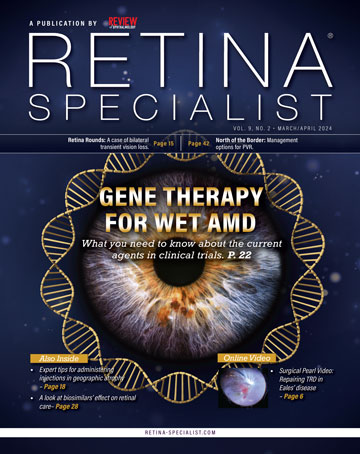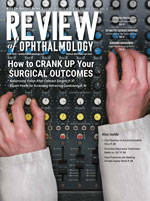About one year ago, we were concerned that chaos would occur and the claims processing system we rely on daily might collapse following the implementation of ICD-10. As we know, the system did not collapse and most claims were processed without incident.
The most common challenges occurred with coverage for diagnostic tests like optical coherence tomography scans. Some Medicare contractors omitted or overlooked adding some of the new ICD-10 diagnosis codes to Local Coverage Determinations (LCDs) that spell out coverage for particular services like surgical or diagnostic procedures. In several areas, new diagnosis codes were not on the October 1, 2015, LCDs, causing erroneous denials. The contractors were responsive to medical societies and individuals and updated the LCDs accordingly.
The Centers for Medicare & Medicaid Services (CMS) also stipulated in its July 2015 publication “CMS and AMA Announce Efforts to Help Providers Get Ready for ICD-10 Frequently Asked Questions” that, beginning October 1, 2015, they would not deny or audit claims as long as the diagnosis coding remained in the correct “family of codes” over the next 12 months. CMS stated:
While diagnosis coding to the correct level of specificity is the goal for all claims, for 12 months after ICD-10 implementation, Medicare review contractors will not deny physician or other practitioner claims billed under the Part B physician fee schedule through either automated medical review or complex medical record review based solely on the specificity of the ICD-10 diagnosis code as long as the physician/practitioner used a valid code from the right family.1
Diabetes Changes
But the one year of leniency is ending. Combine that with multiple additions and some deletions to retinal conditions and there is significant preparation to do before October 1 this year. To begin, the diabetes mellitus (DM) sequences contain hundreds of changes in categories E08 through E13. The diabetic retinopathy codes now have laterality, making them seven digits. Laterality is represented in the seventh digit where “1” means right, “2” means left, “3” is bilateral and “9” unspecified. For example, we now have the following sequencing:
• E11.3511—Type 2 DM with [proliferative diabetic retinopathy] with macular edema, right eye.
• E11.3512—Type 2 DM with PDR with macular edema, left eye.
• E11.3513—Type 2 DM with PDR with macular edema, bilateral.
• E11.3519—Type 2 DM with PDR with macular edema, unspecified eye.
In addition to laterality throughout the diabetic sequences, multiple combination codes describing other diabetic complications exist in the update. Specifically, codes associated with retinal detachments include the following (“_” is the place for the laterality code):
• E11.352_—Type 2 DM with PDR with traction retinal detachment involving the macula.
• E11.353_—Type 2 DM with PDR with traction retinal detachment not involving the macula.
• E11.354_ Type 2 DM with PDR with combined traction retinal detachment and rhegmatogenous retinal detachment.
ICD-10-CM also added the following codes for stable PDR and PDR without macular edema (“_” is the place for the laterality code):
• E11.355_—Type 2 DM with stable PDR.
• E11.359_—Type 2 DM with PDR without macular edema.
AMD Changes
Several other areas in the “H” chapter contain additions. Last year, many physicians voiced their disappointment when age-related macular degeneration did not at least have laterality. H35.31 (nonexudative AMD) and H35.32 (exudative AMD) are now header categories requiring greater specificity, including laterality. In contrast to the change noted for diabetic retinopathy, the sixth slot for AMD represents laterality (right, left, bilateral) while the seventh slot represents staging of the disease. For example (“_” is the place for the staging code):
• H35.311_—Nonexudative AMD, right eye.
• H35.312_—Nonexudative AMD, left eye.
• H35.313_—Nonexudative AMD, bilateral.
• H35.319_—Nonexudative AMD, unspecified eye.
The code requires a seventh digit designating staging as follows:
• 0—Stage unspecified.
• 1—Early dry stage.
• 2—Intermediate dry stage.
• 3—Advanced atrophic without subfoveal involvement advanced dry stage.
• 4—Advanced atrophic with subfoveal involvement.
Putting it all together, the code for a patient with bilateral intermediate dry AMD is H35.3132.
Similar changes to exudative AMD include laterality with the different stages of wet AMD also defined by the seventh character.
• H35.321_—Exudative AMD, right eye.
• H35.322_—Exudative AMD, left eye.
• H35.323_—Exudative AMD, bilateral.
• H35.329_—Exudative AMD, unspecified eye.
The required seventh character stages for wet AMD are as follows:
• 0—Stage unspecified.
• 1—With active choroidal neovascularization.
• 2—With inactive choroidal neovascularization with involuted or regressed neovascularization.
• 3—With inactive scar.
A patient with wet AMD with active CNV in both eyes is coded as H35.3231. Unfortunately, diagnosing AMD is no longer as simple as H35.31 for dry and H35.32 for wet. Staging and laterality are now required components.
Vein Occlusion Changes
Central and branch retinal vein occlusion (CRVO and BRVO) diagnoses change notably. We currently use H34.81_ for CRVO and H34.83_, with the sixth digit representing the eye, similar to AMD. The changes include adding the seventh slot to describe associated macular edema or neovascularization as:
• 0—With macular edema.
• 1—With retinal neovascularization.
• 2—Stable (pre-existing CRVO or BRVO).
Before October 1, we would be using two ICD-10 codes for BRVO with macular edema.
Preparation
In preparing for October 1, several areas deserve attention:
• Acquire a new ICD-10 CM manual. CMS has a free version.2
• Speak with electronic health record and practice management system vendors to insure updates are complete.
• Update cheat sheets.
• Review LCDs from Medicare and other payer policies for updates for diagnostic testing. Watch for effective dates on or after October 1, 2016.
These items represent some of the many changes effective October 1 relevant to retina subspecialists. Review the updated ICD-10-CM manual for additional changes. Leniency is about to end. Avoid using “unspecified” codes, unless you have no other choice.
Mr. Mack is a senior consultant with Corcoran Consulting Group. He can be reached at 1-800-399-6565 or at www.corcoranccg.com.
REFERENCES
1. CMS and AMA announce efforts to help providers get ready for ICD-10: Frequently Asked Questions. Centers for Medicare & Medicaid Services. Baltimore, Md. Guidance issued July 2015. Available at: https://www.cms.gov/Medicare/Coding/ICD10/Downloads/ICD-10-guidance.pdf. Accessed August 17, 2016.
2. 2017 ICD-10-CM and GEMs. Centers for Medicare & Medicaid Services. Baltimore, Md. Page modified August 22, 2016. Available at: https://www.cms.gov/Medicare/Coding/ICD10/2017-ICD-10-CM-and-GEMs.html. Accessed August 29, 2016.



